Aromatisation
Video Solution
Text Solution
Alkanes containing six or more carbon atoms when heated to high temperatures (about 500∘C or 773 K),
under high pressure (10-20 atomspheres) and in the presence of catalysts (such as oxides of chromium, vanadium and molybdenum supported on alumina), get converted into aromatic hydrocarbons. For example, n-hexane changes into benzene when passed over chromic oxide supported on alumina, at 773 K.

The reaction involves cyclisation and dehydrogenation. It is used in petroleum industry to convert acyclic compounds (present in petroleum) into aromatic compounds.
|
Updated on:21/07/2023


